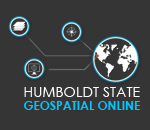Selecting and Obtaining Data
Introduction
When selecting and obtaining data for a project your first need to identify the project goals and the resolutions needs. This includes the type of remote sensing (active vs passive), the resolution needs and the cost and availability of data.
Sensor Type and Resolution
Sensor Type
Depending on the application, you will want to consider what type of remote sensing is needed. There are two primary types of remote sensing, active and passive. Most satellite based systems are passive, meaning they detect natural energy or radiation that is emitted or reflected by objects. In some applications, active remote sensing might be more appropriate. This includes all systems that provide their own energy, like Radar or Lidar systems.
Resolution
When considering resolution needs for a project, all four types of resolution need to be considered:
- Spatial
- Spectral
- Radiometric
- Temporal
It is nearly impossible to acquire imagery that has high spatial, spectral, radiometric and temporal resolution. This is known as Resolution Trade-off, as it is difficult and expensive to obtain imagery with extremely high resolution. Raster files also grow exponentially in files size as the resolution increases. Therefore it is necessary to identify which types of resolutions are most important for a project and prioritize these resolutions when looking for data.
Cost and Availability
While data like Landsat are free, other data sources may cost a significant amount of money. It is important to consider cost and your project budget when choosing data. You will also need to determine the availability of the data. If you have budget and time you may be able to obtain your own data (using unmanned aircraft systems) or contract out the data acquisition
Data Sources
There are many different data sources available on the internet. The below list is not a complete list, but a guide listing some of the available resources:
- EarthExplorer- Search, and order satellite images, aerial photographs, and cartographic products from multiple sources.
- The National Map -Download Elevation, Orthoimagery, Hydrography, Geographic Names, Boundaries, etc.
- Forest Service Geodata Clearinghouse - The USDA Forest Service Geodata Clearinghouse is an online collection of digital data related to forest resources.
- National Park Service GIS Data –Geospatial data search from the National Park Service
- Global Administrative Areas (GADM) - Spatial database of the location of the world's administrative areas (or administrative boundaries).
- US Census TIGER - spatial data from the Census Bureau's MAF/TIGER database, containing features such as roads, railroads, rivers, as well as legal and statistical geographic areas.
- State of California Geoportal – Geospatial data resources for the State of California.
